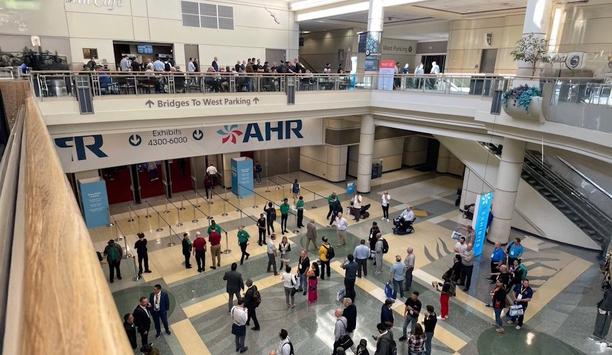Energy consumption continues to be one of the primary contributors to a building’s carbon emissions and its operational costs. Around 40% of this energy is used to power HVAC systems. To improve sustainability and reduce operating costs, it’s in a building owner’s best interest to find ways to make their building’s heating and cooling systems more efficient.
Identifying areas that will make the biggest difference starts with knowing which systems consume the most energy. Chillers are often used by industrial and large-scale HVAC systems to provide comfort cooling in commercial buildings.
Improving chiller efficiency
These systems account for over a third of total HVAC energy use for commercial buildings that use water-cooled systems and two-thirds of total energy use within a chiller plant itself. This considerable amount of energy consumption makes improving chiller efficiency a prime opportunity for a building owner to advance sustainability and reduce costs.
These systems account for over a third of total HVAC energy use for commercial buildings
One way to optimize chiller energy consumption is by selecting a chiller that is equipped with variable-speed drives (VSD). VSDs can help commercial property owners improve chiller efficiency in any climate over the equipment’s projected life span. Load and lift are two factors that determine chiller efficiency. Load indicates how much heat a chiller can remove in an hour, while lift determines how much work a chiller must do to remove that heat.
Chiller energy consumption
Of the two, lift has a greater impact on chiller energy consumption. It’s measured by the difference between evaporator pressure and condenser pressure however, the lift can also be measured by the temperature difference between the hot water leaving your condenser and the cold water leaving your chiller to circulate through your building. The greater the lift, the more work a compressor must do.
Load can also be described as the flow of refrigerant and the amount of cooling a chiller can provide. It’s often indicated as part load or full load. Full load is the maximum cooling capacity a chiller is designed to provide. Part load is anything less than that. In the real world, chillers only operate at their maximum capacity, or full load, about 1% of the time; however, in order to keep occupants, cool on the hottest days of the year, they must be designed to operate at this maximum capacity. The rest of the year, chillers operate at part-load, or off-design, conditions.
Fixed-Speed chillers
These methods can introduce mechanical losses, which can impair energy efficiency
A variable-speed drive is a device that can alter the speed of a fixed-speed motor by changing the frequency and voltage the motor receives. In chillers, this means VSDs can vary compressor motor speed to match capacity. When capacity requirements are low, the VSD can slow the compressor motor and reduce how much energy is consumed.
Before VSDs, only fixed-speed chillers were available. These chillers run, as their name suggests, at a fixed or constant speed. Since the motor speed doesn’t change, capacity is controlled through mechanical means, such as slide valves and pre-rotation vanes. These methods can introduce mechanical losses, which can impair energy efficiency. Fixed speed chillers are optimized for design-day conditions, meaning that they are engineered for efficiency when operating at full load on the hottest days of the year.
Commercial buildings experience
At part load and low load, which are all the other days, the cooling efficiency in these chillers suffers. As one might guess, most commercial buildings experience more off-design loads than the conditions for which they were designed.
A VSD, in comparison, enables a compressor to control the flow of refrigerant
At lower load, the compressor motor in a fixed speed chiller must work against mechanical losses caused by slide valves, which can be found in screw chillers, or inlet guide vanes, found in centrifugal chillers. At part load, a constant-speed chiller typically closes its pre-rotational or inlet guide vanes to regulate the flow of refrigerant. This closing action becomes a restriction that reduces compressor capacity and efficiency. A VSD, in comparison, enables a compressor to control the flow of refrigerant with reduced need for mechanical restriction.
Lower capacity requirements
Centrifugal inlet guide vanes can stay open longer and screw compressor slide valves may be eliminated, which means there are fewer if any mechanical losses. Without mechanical losses, the compressor can be optimized at off-design conditions through the whole operating range. When a VSD is slowed to match lower capacity requirements, the chiller uses less energy.
VSDs have the potential to reduce the amount of energy a chiller consumes over a year by nearly a third across a broad range of conditions without sacrificing operational reliability. This can keep occupants comfortable regardless of the weather outside. Thanks to the amount of energy they save, most of today’s chillers are designed with VSDs.
Fixed speed chillers
At off-design conditions, a VSD chiller can save up to four times the energy of a constant-speed chiller
At part load, a chiller with VSD will automatically reduce the speed of the compressor motor to match the load. By reducing the speed, a chiller with VSD will use less energy at part-load conditions than a constant-speed chiller would. At off-design conditions, a VSD chiller can save up to four times the energy of a constant-speed chiller if the tower water temperature can be reduced or the chilled water supply temperature can be increased.
Although chillers with VSDs consume a bit more energy compared to constant or fixed speed chillers when operating at full load, at off-design conditions, where a chiller operates most of the time, a VSD reduces a chiller’s energy use by up to 30% when functioning at partial load. These savings can rise to more than 60% if the entering cooling temperature can also be reduced.
Improving energy efficiency
Building owners can further improve energy efficiency by lowering lift. It’s possible to see a 20% increase in efficiency by simply reducing chiller lift by 10 degrees, from 85 F to 75 F. However, these efficiencies can only be achieved by chillers that can operate in low-lift conditions. Conditions like this include using 55 F or 45 F tower water temperatures with full condenser water flow, which are 20 F and 30 F colder than the 75 F water temperatures used by traditional chillers.
Building owners can further improve energy efficiency by lowering lift
VSD chillers that operate with reduced load and lift and achieve these greater energy efficiencies can quickly return their investment through energy savings. Many facility owners can see a payback in less than two years and enjoy continued savings long after.
Improving energy efficiency
For new buildings with more than one chiller, facility owners can improve energy efficiency at the design stage. Operating many chillers at lighter loads can save a significant amount of energy compared to heavily loading one or a few.
A chiller’s rated efficiency doesn’t necessarily equal a chiller plant’s efficiency. The efficiency of a multichiller plant comes down to the number of chillers in it and their size. Although the building’s type and the weather experiences will influence energy consumption, for optimal efficiency it’s critical to closely match capacity to load across the full load profile. The chiller loading pattern in a multichiller plant is different than a single-chiller plant. Since there’s usually redundant equipment, the total capacity required for a multichiller plant is typically less than the total capacity of all the chillers.
Total load requirement
From an energy standpoint, it’s far more efficient to choose the latter
A multichiller plant with eight VSD chillers, for example, may have a total load requirement of 50% capacity on any given day. To keep occupants comfortable, the chillers can operate one of two ways: four of the chillers at full load or all the chillers at half load. From an energy standpoint, it’s far more efficient to choose the latter. It will reduce the chiller input power by 2.5% to 3%, even with design-condition entering condenser water temperature (ECWT).
It’s recommended to implement sequences for chiller/tower/pump sets so that chillers operate as closely as possible to their natural curves. If the ECWT can be reduced, the savings can be even greater. At 55 F, for instance, facility owners can see a savings of 35% compared to other variable-speed equipment and up to 50% compared to constant-speed chillers.
Variable-Speed technology
Instead of maximum load, the chillers operate at lighter loads, saving energy. Each plant is different, so the pumping strategy and cooling tower configuration can also affect performance.
Instead of maximum load, the chillers operate at lighter loads, saving energy
Variable-speed technology can also benefit the efficiency in this equipment. Variable-speed drives were invented to optimize power use and minimize the amount of energy that devices consume. Chillers with VSDs can be a reliable way for facility owners to reduce the amount of energy that their building’s HVAC systems use.
Annual operational costs
Improving chiller efficiency in this way not only lowers annual operational costs, but it also improves the performance of a building and its sustainability. A more energy-efficient chiller can considerably shorten its payback period, alleviate carbon emissions and contribute toward ENERGY STAR® Building and LEED ratings.
Facility owners can realize significant energy savings over the life of their chiller throughout the world, keeping occupants comfortable in all conditions and creating more efficient, more sustainable buildings.


















